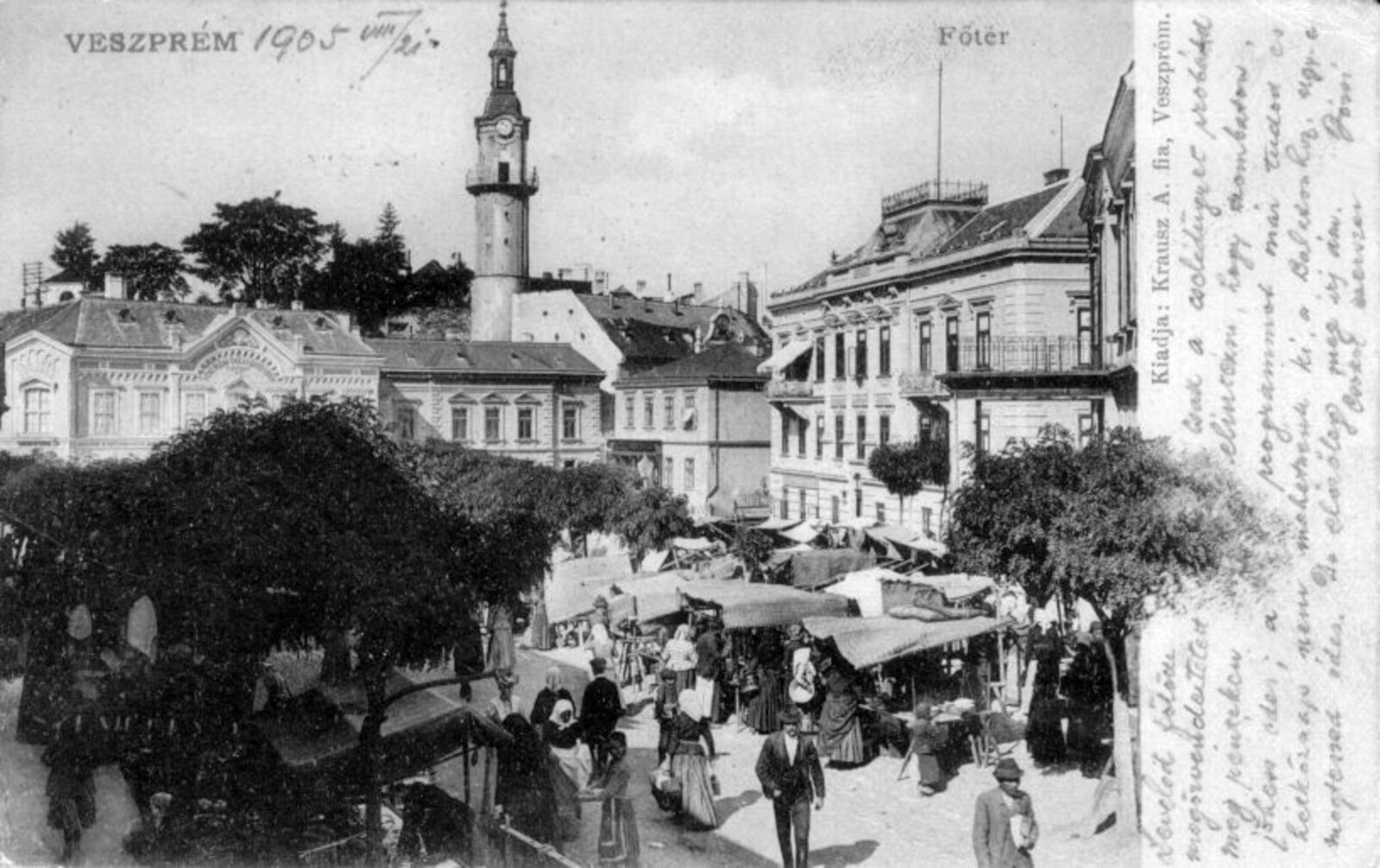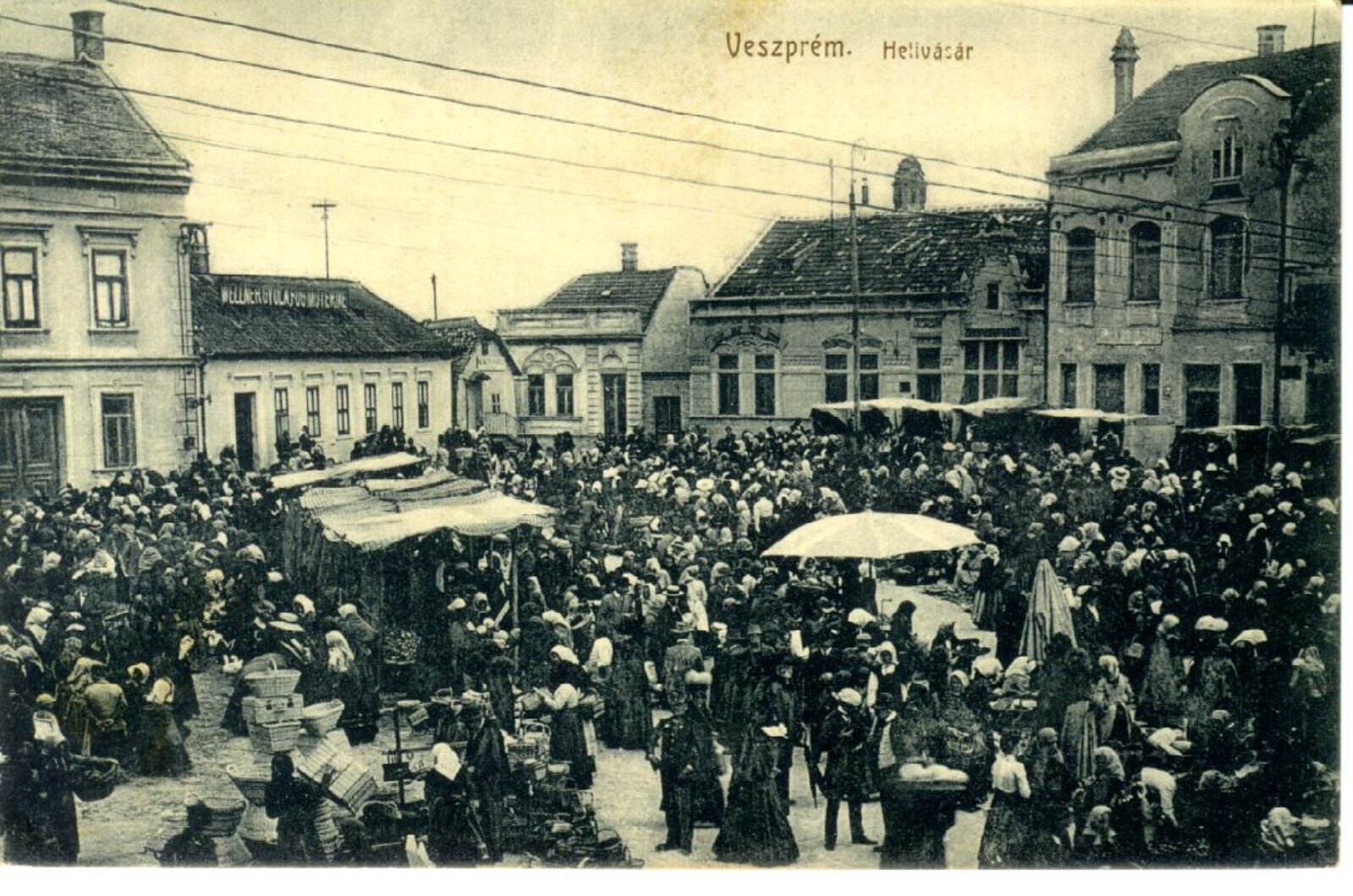City Centre Building Tours: The history of Old Town Square and Old Town Market
Fairs have been organised in Veszprém since the times of Turkish occupation, when Old Town Square was still guarded by soldiers from border castles guarding Hungary from the Ottomans. This is also attested by engravings from the period. This was the market centre of the town until 1946, and after 70 years, the tradition was revived in autumn 2021 with the help of the VEB2023 ECoC. Learn more about the history of Old Town Square with our tour of city centre buildings!

The trade turnover of Veszprém mainly came from the sale of grain and wine, which were also produced in large quantities in the area, via wholesale intermediary trade. Until the construction of the southern railway in the 1860s, 'seven counties brought their grain to the market in Veszprém'. Small-scale producers in and around the town also brought in the fruit and vegetables, milk and dairy products needed for daily consumption. In a ddition to the town's craftsmen and traders, itinerant merchants also appeared with their wares.
Fairs of national importance were held in Veszprém on the Mondays of the weeks of 6th January, 14th February, 12th March, 4th May, 21st September and the first Monday of November, and every Tuesday and Friday there was a weekly fair. The weekly markets on Fridays were held at the Great Market (today's Óváros Square), where foodstuffs and craftsmen's wares were sold. The oldest market in the city, the Small Market (on the site of today's Gizella Hotel), was the only place where firewood was sold in the 19th century. The wine market was located in Kopácsy Square (today's Szabadság Square), the pig market in the area of Balog Lake (today's Vörösmarty Square), and the grain market in Vásárállás (today's Hotel Veszprém), a place that was also suitable for national fairs.
The two lords of the town (the Bishop of Veszprém and the Chapter) had the right to hold fairs (and thus to collect local tax), which was bought from them by the town of Veszprém in 1901. A Veszprém citizen thus no longer had to pay a rental fee for their place in the fair. This meant that the local craftsman had an advantage over the one from the surrounding countryside. The price scale painted a colourful picture of the fairs of the time. There were pedestrian vendors selling scarves, ribbons and lace. Milk, butter, curds, eggs, fruit and vegetables were sold from handbaskets, vats or barrels, but they were paid for at different rates when sold on tables, stands, wheelbarrows or on the ground. Market tents occupied an average of 4 square metres of floor space.
Grain, potatoes, carrots were brought in barrows, carts and sacks, fish in crates, wine and pálinka in barrels. Fishermen sold their wares on the south side of town hall, and the people of Alsóörs regularly brought freshly caught pike-perch. The fish were of the night catch and were on the market by 11 a.m. They were still wriggling in their baskets. At the end of November, there was also swordfish from Tihany and catfish from Aszófő, whose ten-kilo specimen fetched the price of a hundredweight of wheat. Farmers from the Balaton Uplands also offered must, grapes and new wine.

Bakony producers sold special plums, apples and pears. Of the latter, the most famous was the the one with the purple inside, a small but tasty fruit. They were also dried in winter, but still counted as a delicacy. There was also a wide range of sweets: Turkish Delight, gingerbread, mead, or márc, a sweet drink made from the by-product of honey. Birch wort, made from the scratched bark of the birch tree, was a refreshing and healthy drink, which is still highly regarded today for its beneficial effects.
Wooden tools were brought to the market: forks, baking spatulas, rakes from Szentgál, Olaszfalu and Bakonybél. Charcoal burners were also present, as were potters with cups, mugs, bowls and plates. The Britter family specialised in sieves and fibres, and there were also rope makers, tailors and weavers. The Bakony artisans who made cifraszűr, an embroidered men's coat, worked locally in Séd Valley. The turners shaped the simpler and the more elaborate csutoras decorated with the Hungarian coat of arms or a Kossuth portrait. This wooden vessel is lightweight and keeps heat well, so wine and pálinka were stored in it. During the Napoleonic wars, barrels were ordered annually by the army in their hundreds of thousands from Veszprém.The coopers were masters of the barrel, and the furniture makers of the Bakony also brought in inlaid pieces to please the German immigrants, who had settled here, for example from Nagyvázsony. So-called healre women also appeared as traders, selling medicinal herbs.
The shops and restaurants around the square were ready to welcome the farmers and catered for their every need. There was a casino, a restaurant and a ballroom, and a lower-priced pub. Károly Bauer's butcher's shop in the north-east corner of the square, was famous. It sold such specialities as wild boar and grey cattle meat. Colonial goods, coffee and spices were sold on the site of what is now Elephant Restaurant, books and printed matter in Pósa House. There used to be steam baths and a surgery; two famous pharmacies sold medicinal bitter spirits to heal the stomach prepared to their own recipes. In the tavern Kispipa next to the Francsics Staircase there was a brothel. As Sándor Rosenthal, a former historian of the town, once described it:
'with its charming, patriarchal atmosphere, Piacdomb (Market Hill) was reminiscent of the German towns.

Changes in the Function and Name of the Square
The name of the fairground has changed several times. It was called quite naturally after its function as Piacdomb or High Street until the early 20th century, when it was renamed Rákóczi Square in 1907 in a programme to bring a system and order to street names.
Rákóczi Square (1907-1950) - The street-naming (in a historicist style, in the spirit of the cult of Rákóczi) coincided with the extension and reconstruction of the market square. Between 1907 and 1911, a dozen or so buildings were demolished in the square (including the Gentlemen's Casino on the site of present-day City Hall and the single-storey house on the site of Rosenberg House) - the square's open area more than doubled, and it was then that its final contours were established and its Art Nouveau houses were built. The vibrant life and activity of the square was mainly generated by the market, the merchants' wares and the hospitality facilities. This was only enhanced by the frequent visits or passing through of nationally renowned politicians, prominent personalities and church dignitaries.
Red Army Square (1950-1990) - This centuries-old tradition was broken in 1945. To "commemorate the 5th anniversary of our liberation", the name Red Army was affixed to the square as a symbol of surrender, and its function also changed. On 23rd March 1946, a red-starred, red-stone obelisk, the so-called Russian Heroes' Monument, was erected and inaugurated in Market Square. For a decade, the market was replaced by the long-distance bus station, and for nearly 50 years, the commemorations of 'revolutionary spring', 1st May and 7th November, the inaugurations of little drummers and pioneers, and social events were held here.
Óváros (Old Town) Square (from summer 1990) - The new name, which suggests the meaning of the historic main square of the city centre, was given after the systemic change and was quickly embraced by the people of Veszprém, but it has been difficult to fill the space with appropriate content for the city's main square and even harder to fill with vibrant life.
